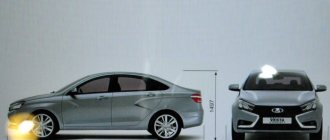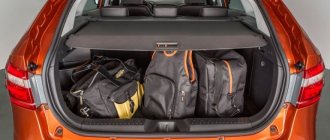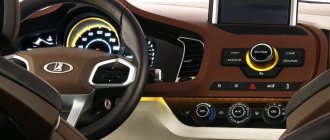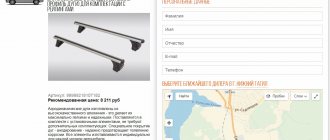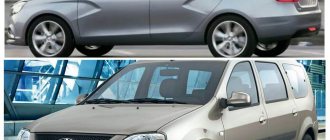Updated Lada sw cross
It was first presented to customers last summer. Together with the station wagon, the sw cross model appeared.
It visually stands out among other AvtoVAZ cars. Along the perimeter of the car there are plastic linings that are used as decoration and also for protection. The bumper has been modified: more voluminous and streamlined. Fuel tank cap opens with the push of a button, shark fin antenna, factory size 17 alloy wheels.
The interior has also been improved. The front instrument panel is illuminated with white light, the area of the rear row of seats is illuminated using a lamp. The front passenger/driver seat is divided by an armrest, which is used for comfort, and also as a panel on which there is a power outlet, a USB port, and a button for turning on the heated rear row of seats. Orange-colored inserts were used for interior decor.
The difference between SW Cross and regular Vesta
The SV Cross differs from the basic station wagon by the presence of a plastic body kit and wheels with a diameter of 17 inches. The ground clearance has been increased to 20.3 cm (instead of the standard 17.8 cm). The new Lada has already been compared to the Renault Duster crossover. The domestic car is superior to the French “competitor” in terms of length and even ground clearance.
The developers also improved the already good suspension from the regular Vesta, shock absorbers and springs were replaced. This has led to the fact that the Vesta Sw Cross 2022 holds the road and handles even better than the Lada without the “Cross” prefix.
Exterior
The rear door opening has increased, and the window frame has also “raised.” The roof slope has become flatter. This makes the position of passengers in the rear seat more comfortable, because There is enough space between their heads and the ceilings.
The inclination of the rear pillars is the same as on all bodies with a shortened rear overhang - slightly forward. The fifth door connector resembles a shark fin and runs along the top of the pillars.
The body of the 2022 Lada Vesta SV Cross is 15 cm higher than the classic sedan, and slightly wider thanks to the wheel arches. The new Lada is equipped with rear disc brakes. But this update is only for “advanced” versions.
The fuel filler flap now has a central lock, with which it is locked and latched. The protruding “ear” has been removed. The modernization also affected the trunk lock: now it opens and closes using a button. It is located under the license plate.
The design of the antenna has changed: instead of a twig that will remain on the sedan, it finally took the shape of an elegant fin. The exhaust pipe is equipped with a double-barreled nozzle (the base model does not have this upgrade).
The color scheme of the 2022 Lada Vesta SV Cross includes 10 shades. All of them are bright and juicy, which gives the car even more charisma. Each, according to AvtoVAZ tradition, has its own name - “Mars”, “Glacial”, “Black Pearl”. This is a “stretch” of monochrome colors - from pearly white to elegant black, as well as orange and red shades.
Interior
In front, between the seats, there is a box armrest. And the rear sofa is equipped with a folding armrest. The instrument scale has a stylish design.
Inside, the upholstery of the Lada Vesta SW Cross 2022 is made in the same colors as the exterior trim. For example, the shade “mars” is a metallic orange color. Inside the cabin, the standard dark graphite paint on the seats is combined with orange stripes and dark gray accents. The inner sides of the doors and the control panel are decorated in the same style.
The steering wheel comes complete with control units and a massive suspension. The design of the instrument console in the form of three “wells” is just like on sports cars. The central panel has a small display and control units.
Design
The appearance of the domestic station wagon can be called classic relative to all modern models produced by AvtoVAZ. At the front there is a recognizable “X-face”, which the manufacturer creates using inserts between the headlights and the radiator grille. There are also stampings on the sides, wings and doors, which are typical for all modern AvtoVAZ models. The roof of the station wagon has received a serious slope towards the luggage compartment, thanks to which the car looks quite modern and does not create the impression of bulkiness. At the rear, you can note a fairly compact tailgate, on which the manufacturer installed a neat spoiler.
The interior design does not have any frills or original solutions, but at the same time, it looks quite ergonomic. Thanks to the manufacturer’s decision to extend the center console somewhat deeper into the cabin, the driver and front passenger will be able to configure the multimedia system and control the air conditioning unit without any difficulty.
The interior seats are moderately hard and equipped with additional lateral support. The station wagon's interior is quite spacious; three passengers can easily fit in the back.
What's expected in the future?
New Lada Vesta engine The Russian concern is not going to stop with those models that are already on sale. They plan to install a foreign engine from the Renault-Nissan alliance on the sedan. Its power is determined to be 118 hp, and its volume is 1.6 liters. In the future, there is an idea to mount a 120-horsepower/1.8-liter unit under the hood of the Lada Vesta.
Important!
With an increase in the main parameter of the motor, the torque indicator increases, which affects the rotation speed of the wheel rims. Lada Vesta with a new engine from Renault-Nissan will be able to accelerate to 185 km/h.
Dynamic qualities and fuel consumption
You simply can’t expect any serious dynamic performance from naturally aspirated engines of 1.6 and 1.8 liters. At the same time, the 2022 Lada Vesta SV acceleration rate to 100 km/h coincides with similar values of its competitors. On the highway you can count on fairly confident and stable acceleration and maintenance, but in city conditions you shouldn’t expect Vesta to be able to make a sharp maneuver.
Regarding the fuel consumption stated by the manufacturer, we can also say that this value is average. The car does not demonstrate any exorbitant results in this parameter, but a value of 7-8 liters cannot be called excessive.
How has the acceleration changed?
Finally, the fun part! Having installed the sensors and hung the Racebox, we accelerate, pressing the gas pedal all the way. Slight wheel slip, the car feels heavy, winter tires can’t cope well. We reach 60 km/h in 11 seconds, 5500 rpm, 5800, switching... The overloaded Vesta SW Cross accelerated to 100 km/h in 23 seconds. It's time to pull out the bricks.
We start from the same place where we started on Vesta with the cargo. Pedal to the floor. You immediately feel that the engine is much easier: 40 km/h... 50... the engine very quickly reaches its maximum speed, 5800–5900. Vesta SW Cross with driver and passenger accelerated to 100 km/h in almost 17 seconds. And this is on a snowy road.
To summarize the experiment, we note that an unloaded Lada Vesta CVT drives differently as expected. The car reacts responsively to the steering wheel, the rear suspension operates smoothly and copes well with hard bumps. But the main conclusion is that even on an overloaded Vesta SW Cross with a CVT you can drive confidently. It has enough dynamics and, more importantly, brakes.
Lada Vesta with a CVT and high overload: it drives cheerfully!
Salon Lada Vesta 2022
The interior of the presented model will become an indispensable reflection of modern style and elegance, where the creators have taken into account every detail and element. According to experts, numerous mechanisms have been changed radically, which provides an undeniable advantage. What has changed? Consider:
A huge number of elegant and smooth lines have been added to the working panel. The instrument panel includes three different instrument niches surrounded by chromed metal surrounds. Bright turquoise lighting has become a rather interesting idea that attracts attention. It will not be distracting and makes it possible to see instrument indicators even at high speed. The new format steering wheel has three spokes
At first glance, it is very similar to foreign cars. An eccentric central panel that displays a 7-inch monitor, two useful deflectors, and a climate control unit. The separate panel provides various useful buttons and controls. The steering wheel has additions in the form of control buttons. The quality of finishing materials pleasantly surprised. The plastic has become hard, but the fabric upholstery is practical and durable. The front seats are equipped with all the necessary adjustments. The rear seats accommodate three people perfectly. The trunk has a capacity of 480 liters of cargo.
Maximum speed of Lada Vesta in various trim levels
The technical characteristics of the new AvtoVAZ product indicate that the highest acceleration rate is 178 km/h. This value applies to all models, regardless of the build and power of the power unit.
Measurements vary depending on terrain conditions and driver skill. All tests carried out by experts and amateurs more or less coincide with the stated figures in the passport. However, it is alleged that someone managed to accelerate the Lada Vesta to 200 km/h. The test results are as follows:
- The new AvtoVAZ with a 106 horsepower engine and manual transmission accelerated to 174 km/h.
- A model with a 106 hp engine, but with an automatic transmission, gives a maximum speed of 178 km/h.
- Lada Vesta manual and with internal combustion engine 114 hp. accelerates to 180.
Characteristics of Lada Vesta SV station wagon 2017-2018
Below are the main technical characteristics of the Lada Vesta SW station wagon / Lada Vesta SV 2017-2018 in a new body for the Russian market. The table shows the main parameters: overall dimensions, fuel consumption (gasoline), ground clearance (clearance), mass (weight), trunk and tank volume, engines, gearboxes, drive type, dynamic characteristics, etc.
Body
| Body type | station wagon |
| Car class | class B |
| Length / width / height, mm | 4410 / 1764 / 1512 |
| Wheelbase, mm | 2635 |
| Ground clearance (ground clearance), mm | 178 |
| Trunk volume, l | 480 / 825 |
| Curb weight, kg | n.d. |
| Fuel tank volume, l | 55 |
Engine and transmission
| engine's type | petrol | petrol |
| Volume, l | 1,6 | 1,6 |
| Power, hp | 106 | 106 |
| Torque, Nm | 148 | 148 |
| Gearbox type | Mechanics | robot |
| Number of gears | 5 | 5 |
| Drive unit | front | front |
| Acceleration 0-100 km/h, s | 12,4 | 14,4 |
| Max speed, km/h | 174 | 174 |
| Fuel consumption, l | ||
| - city | n.d. | n.d. |
| - track | n.d. | n.d. |
| - mixed | 7,3 | 7,0 |
| Fuel type | AI-95 | AI-95 |
Engine and transmission
| engine's type | petrol | petrol |
| Volume, l | 1,8 | 1,8 |
| Power, hp | 122 | 122 |
| Torque, Nm | 170 | 170 |
| Gearbox type | Mechanics | robot |
| Number of gears | 5 | 5 |
| Drive unit | front | front |
| Acceleration 0-100 km/h, s | 10,9 | 12,9 |
| Max speed, km/h | 180 | 182 |
| Fuel consumption, l | ||
| - city | n.d. | n.d. |
| - track | n.d. | n.d. |
| - mixed | 7,8 | 7,6 |
| Fuel type | AI-95 | AI-95 |
For additional technical information, please contact official dealers.
roadres.com
What is the 203 mm ground clearance of the Lada Vesta SV Cross suitable for?
So, 203 mm - what is it? This is a ground clearance that in most cases will be comfortable for different types of drivers. Yes, the ground clearance of the Lada Vesta Cross SV is not suitable for real off-road conditions, but it is quite suitable for rough terrain.
The Lada Vesta SV Cross was conceived as an all-terrain station wagon, but not the entire concept of the car speaks about this. Firstly, there is only front-wheel drive, which has no chance off-road. Secondly, Vesta Cross SV does not have any off-road “assistants” such as locks and anti-bux. Thirdly, the standard wheels on the Vesta SV Cross are, in principle, not for driving on off-road routes. Agree, 205/50 R17 tires are generally out of place here. These are generally ordinary low-profile tires. It was more appropriate to increase the profile while reducing the diameter of the disk. But, it is as it is.
Why then is Vesta Cross SV needed at all? Many journalists and experts have come to the conclusion that the ground clearance of the Lada Vesta SV Cross is ideal for city and highway driving and infrequent cross-country trips. And the dimensions of the Lada Vesta Cross SV are similar to the sedan version.
For example, you live in a village and in the winter you need to overcome roads that are poorly cleared of snow, and then move around the city. Is Vesta Cross SV suitable in this case? Yes, definitely. In this case, buying an SUV is not economically profitable, since it means extra fuel consumption, higher taxes, and additional expenses for consumables. And for mostly driving around the city, an SUV is needed only for show-off. Vesta Cross SW in this case will be the most profitable solution. It consumes little gasoline, and the tax on it is small, and due to its ground clearance it can overcome snow obstacles with ease. And it’s comfortable to drive in the city.
Or the second example. You and your family go to the dacha in the summer. The road to the dacha site first goes along the highway, and then smoothly turns into a dirt road with a not very good surface. In some places you need to overcome sections of the road washed out by the river in spring. Do you need an SUV here? More likely no than yes. Vesta, with its ground clearance of 203 mm, will be able to cross many uneven surfaces. And it will behave steadily on the track due to good weight distribution. Again, saving on fuel, tax costs, etc. compared to an SUV.
But if you plan to ride Vesta for hunting or fishing on real off-road terrain, then the SV Cross is simply powerless. No, you might be able to get somewhere, but if you want to drive the car deep into the taiga, then it’s better to refrain from doing so. There are specially prepared cars for this.
Interior of Lada Vesta 2022
We characterize the interior design as follows:
- The steering wheel is made in a classic style, has two spokes and double lower support.
- The instrument panel has three wells in which the main indicators are placed: speed, revolutions, fuel volume, and so on.
- In the expensive version of the equipment, a multimedia system display is installed on the center console. Below it are placed several push-button control units, one of them is responsible for climate control control.
- Many interior elements have a complex shape and design. Plastic was used for finishing, which imitates chrome strips.
- Fabric is used to trim the seats. Moreover, even in the expensive configuration, the trim is presented in fabric; leather trim is not provided.
The use of modern technologies in the production of this sedan determines that the car looks quite attractive, the elephant can be called practical and quite comfortable.
Ground clearance
The main and biggest plus of the Russian cross-sedan is its high ground clearance. According to factory specifications, its height is 203 mm. Not every modern crossover can boast the same. High ground clearance is needed if you at least sometimes drive off smooth asphalt. However, it is also useful in big cities with their eternal construction sites, speed bumps and curbs that do not comply with GOST. Now remember how they like to raise the suspension, including on sedans, in the provinces. So, Vesta Cross is definitely in trend.
Chassis and ground clearance
An independent suspension with gas-filled shock absorbers saves the driver from any bumps and holes on the asphalt. The use of new technologies has increased body rigidity. A tuned suspension is the key to Vesta's handling - it's a MacPherson strut. Only cars of a higher class can surpass Vesta in this indicator. Models with a 1.8 liter engine in the Exclusive, Comfort and Luxe trim levels received disc brakes.
Rear disc brakes will prevent any accident, and Vesta's high ground clearance (203 mm) helps prevent damage to the underbody of the car. Vesta's interior is devoid of extraneous sounds, because it is difficult to hit obstacles with such a high ground clearance with the bottom - but the point is both in the rigidity of the body and in the sound insulation itself.
Some competitors are superior to Vesta. Renault Duster's chassis is no worse, but the ground clearance is 210 mm.
Ground clearance of Renault Capture is 204 mm. There are also complaints about the chassis of this car, but rarely.
The situation with the Koreans is completely different. Hyundai Creta and Hyundai ix 35 do not have the same high ground clearance. It is only 190 mm and 175 mm respectively. The situation with the Kia model is no better. X-line ground clearance is only 170 mm.
Focus ground clearance 160 mm. It’s unlikely that such a car is worth the risk of driving into the forest.
Skoda has the smallest ground clearance. Total 134 mm.
It is still difficult to find any problems with Lada Vesta, especially with regard to wheels and suspension.
Ground clearance comparison with competitors
The main competitors of Vesta SW Cross are objectively considered to be Lada Largus, KIA Rio X-Line, as well as the initial versions of Renault DUSTER and Hyundai Creta with front-wheel drive. However, the Lada Vesta Cross is not the last among them in terms of ground clearance. So for Largus the ground clearance is 145 mm, for Rio X-Line it is 170 mm, for Renault DUSTER it is 210 mm, and for Hyundai Creta this value is 190 mm. Thus, we can conclude that only the Renault DUSTER SUV can compete in terms of ground clearance, but we should not forget that the design features of the Lada Vesta Cross and the foresight of domestic developers did not easily make it possible to yield to a competitor in this area.
Equipment Lada Vesta gas-gasoline
The car comes in a top-end configuration, runs on gas and is completely environmentally friendly. It includes a multimedia system and all the necessary equipment. There is also a cylinder and space for it in the trunk. The kit includes an Italian-made gearbox, a filling fitting and nozzles. A standard gas cylinder holds 90 liters of fuel. It is enclosed in a protective casing and takes up relatively little space in the trunk. Additionally, the equipment has a service life of approximately 15 years. Compared to the previous modification, the Cross model will boast suspension and a wide diameter of wheel arches, that is, in a more improved version it will be 17 inches. The rear wheels are equipped with an innovative disc-type mechanism. However, such an innovation will become available mainly in expensive station wagon versions.
Out of the ordinary
- , the VAZ-2801
can be considered one of the most interesting . This is a cargo-passenger “deuce” powered by electric traction! The first prototype was created in 1976. From 1980 to 1981, 47 copies were collected and worked at enterprises in Togliatti, Moscow, Kyiv and Crimea. Engine power was 25 kW, maximum speed was 87 km/h, and the range was 110 km.
Differences in the design and interior of the cabin
The off-road version of the station wagon looks beautiful and harmonious. The car in the bright orange “Mars” color, also available for the Kalina Cross hatchback, is one of the most interesting cars in the class in terms of design.
Lada SW is lost against the background of the fit and dashing SW Cross. Large wheels (17-inch) of the original design, which the sedan lacked, look great in the off-road version. Owners of a city 5-door car are content with only R15 and R16 wheels.
The main advantage of the all-terrain station wagon is the presence of a decorative black plastic body kit. This is the first thing your eye catches when inspecting a new car. It looks neat and visually enlarges the wheel arches. The decorative and protective body kit gives the SW Cross brutality and aggressiveness, and is designed to preserve the paintwork when driving on light off-road conditions.
At the rear of the off-road version of Vesta there is a decorative trim - a double exhaust pipe. It looks unusual and original.
Salon
Vesta SW interior
interior of Lada Vesta SW Cross
The all-terrain station wagon differs from the city version of the car in the presence of Cross inscriptions (on the dashboard), original interior lighting, and bright decorative inserts. Otherwise, car interiors are no different from each other.
What is the Vesta Cross capable of off-road?
The Lada Vesta Cross feels confident both on a flat road and on a country road or even off-road. If you like to have an active holiday while driving a car on minor off-road conditions, the AVTOVAZ flagship is ideal for you. “SW Cross” is equipped with such off-road attributes as a protective plastic body kit and increased ground clearance. A protective black plastic body kit reliably protects the paintwork from chips and scratches, and the increased clearance allows you to confidently overcome obstacles on rough terrain.
Let's add to this attributes a powerful and economical engine, an energy-intensive suspension, and from ordinary driving on rough terrain, your trip turns into easy, pleasant and comfortable. The Lada Vesta Cross is also equipped with such options as cruise control and directional stability system, which will help the driver cover tens of thousands of kilometers without feeling tired or inconvenient.
About behavior on the road
Vesta SW Cross and Vesta SW Cross are cars that are identical in architecture, but different in behavior. The city station wagon is more comfortable and softer on the road. It passes joints more accurately and does not react to minor unevenness in the road surface. Suspension failures only occur in large potholes when the driver is clearly relaxed and inattentively driving through broken sections of the road. The Vesta SW station wagon does not have a sporty character, but is responsive to drive, just like the platform sedan.
The off-road version is more rigid and collected. Being behind the wheel of an all-terrain station wagon, taking turns at high speed, is much more fun and interesting. However, more distinct impacts spoil the impression of the trip. This is due to suspension settings, higher ground clearance and the presence of low-profile 17-inch tires.
Another characteristic difference is the less natural force on the steering wheel, although the automaker assures that it has not made changes to the settings of the electric power steering or the parameters of the SW Cross rack.
As a result, Vesta in a station wagon body with 178 mm ground clearance is more collected and comfortable on public roads in usual operating modes. Its bright off-road version pleases only with sharper handling and perky character at speeds of 80-100 km/h.
Is it possible to increase the ground clearance of Vesta SW Cross?
Returning to the mention of the only competitor of the Vesta Cross station wagon in terms of ground clearance - Renault Duster, whose ground clearance turned out to be the highest, I would like to note that for drivers for whom the clearance of the Vesta SW Cross station wagon is not practical enough, they have a real opportunity to raise it height. In order to do this, it is necessary to make a number of modifications.
Increasing the ground clearance at the rear can be achieved by installing metal spacers under the strut support. To carry out such manipulations, you do not need to be a specialist in the field of mechanical engineering; any driver will be able to do this task and will take only 15-20 minutes. As a result of this modification, the rear clearance of the Lada Vesta Cross can be increased by 2-3 centimeters. You can do the same with the front part; this procedure will require the same algorithm of actions from you; the ride height will increase after installing the front strut support spacer.
Advantages and disadvantages
Without a doubt, the restyling of the unique innovation of the Lada Vesta 2018 sedan was mainly beneficial for the car. Now he is much more beautiful, better. New Lada Vesta 2022 (photos, configurations and prices)
looks menacing and is equipped with a lot of new options. The main advantages are:
- beautiful body design;
- improved interior equipped with useful additions;
- excellent build quality;
- a huge amount of modern functionality and control systems;
- excellent finishing with high quality materials;
- budget cost;
- affordable service that everyone can handle;
- excellent visibility.
Among the disadvantages:
- insufficient sound insulation;
- no diesel unit;
- slight acceleration dynamics;
- unstable paint coating;
- possible rolls and leaving the road;
- many of the parts are from imported manufacturers, which are slightly more expensive than domestic ones.
What affects the maximum speed parameter of the Lada Vesta?
This object is a gasoline engine built under the hood, which requires the use of suitable fuel.
Maximum speed Lada Vesta
On a note!
The gearbox affects acceleration, but is never able to increase performance. Untimely switching gears on a manual transmission does not give the desired result. Skillful handling of the manual transmission gives a dynamic start to driving. The automatic machine provides average performance, but reliable gear changes.
Engine performance and fuel consumption
According to the passport data, the fuel consumption of Vesta SV Cross ranges from 7.5 liters per 100 km to 10.7 liters. It all depends on the engine, gearbox and of course on the type of trip.
If you study the passport data on fuel consumption, then the 2180 consumes approximately 7.5-10.7 liters of fuel per 100 km. It all depends on the gearbox and engine. This is relatively little, so with such fuel consumption you can save a lot of money in the long term (considering how expensive gasoline is now) if you use the car every day.
Renault Duster's fuel consumption ranges from 8.2 to 8.3 liters per 100 km. Buyers purchase both a version with a 1.6-liter engine and a model with a two-liter engine.
Renault Capture also boasts low consumption, which ranges from 7 to 9 liters. Versions with 1.6 and 2.0 liter engines are available to buyers.
The consumption of the Hyundai ix35 is slightly higher. Approximately 8.8 liters per 100 km. You can only buy the version with a two-liter engine.
The consumption of the Hyundai Creta is still the same 7 liters as the Capture. Engine versions of 1.6 L and 2.0 L are available.
Kia X-line has less consumption. This is due to the engine size, because buyers purchase a model with a 1.4 liter engine. The consumption of such a car will not exceed 6 liters. The version of the car with a 1.6 liter engine will require approximately 6.6 liters of fuel per 100 km.
Skoda Rapid buyers can buy a version with a 1.0, 1.2, 1.4 or 1.6 liter engine. Fuel consumption is from 5 to about 7 liters.
Ford Focus boasts a consumption of approximately 7 liters per 100 km. Versions are available with engines ranging from 1.4 to 2.0 liters.
Buyers can choose from 2 versions of Vesta with a 1.8 liter engine (122 hp) and one version with a 1.6 liter engine (106 hp). The 1.8 liter engine is optimal, but those who want to save money can safely look towards a less powerful engine.
Rear suspension design
First of all, the rear suspension system of the chassis to the body of the Vesta cross-country vehicle is not a classic or multi-link system, but is inexpensive and compact, namely a beam suspension. Which again provides an increase in ground clearance because:
- the beam itself (1) has a simple welded structure in the form of a pair of longitudinal tubular spars and one transverse arm. At the same time, the wishbone, having a U-shaped or channel section, has the functions of a stabilizer.
- higher springs (3) rest on the beam compared to the springs of conventional West SV with lower (2) and upper (4) inserts;
- shock absorbers (7 and,
 unlike their designs on the front suspension, have separate mounting points from the springs, namely their upper parts have supports (5) inside the wheel arches.
unlike their designs on the front suspension, have separate mounting points from the springs, namely their upper parts have supports (5) inside the wheel arches.
As for the hubs and drum brakes (9), they remain unchanged. Which causes approval among some of our garage experts, since they believe that a drum system is more reliable than a disk one. Others, on the contrary, are confident that the disc brake system is less demanding in terms of contamination.
However, the first and second agree that the manipulation of lifting the car above the road, one way or another, is reflected by the loss of its stability, and to level out this drawback, an increase in the parameters of the suspension stiffness is required.
Actually, in order to achieve the golden ratio between increased ground clearance parameters and achieve optimal road stability, the Vesta SV Cross had to increase the track width.
Compare configurations and prices
The cars differ in the cost of their configurations. The base price for Vesta SW is 654 thousand rubles, and its off-road modification is offered from 770 thousand rubles.
The initial configuration of SW Cross includes the following options:
- Combined seat upholstery made of fabric and eco-leather.
- LED lighting of the interior and entry and exit points in the driver's and front passenger's doors.
- Climate control system instead of standard air conditioning.
- Heated windshield.
- Rain and light sensors.
- 17-inch alloy wheels instead of stamped R15 ones.
All versions of SW cars are cheaper than the more equipped SW Cross.
Reviews Lada Vesta SV Cross AMT
There are a large number of reviews of the AMT Lada Vesta SV Cross on the Internet. All reviews are different, but for the most part the robot on Vesta is a problem-free unit. Although there are also people who are less fortunate. Basically, they spread the main negativity on the Internet. I chose the first 3 reviews I came across about the Lada Vesta robot:
1. Alexander, Orsk
So, the robot is on the Lada Vesta Cross. I quite liked it. Anything is better than a stick. The most unusual thing for me was that you need to control the gear shift with the gas pedal. If you press the gas pedal harder, the speed switches to lower. For example, you are driving 40 km/h in 3rd gear and want to overtake someone, then you press the gas harder and the gear changes to second.
Switching to the next speed occurs by slightly releasing the gas pedal. For example, you press the pedal to the floor, the car takes off, the revolutions increase, for example, to 3.5 thousand, then you release the gas and the gear switches to second. Something like this. In general, this robot is quite a suitable topic. But you have to get used to switching so as not to get stuck on the road. In terms of reliability, I can’t say anything yet, since I’ve been driving the car for two months. During this time nothing broke.
2. Oleg, Petropavlovsk-Kamchatsky.
Last year I bought a Vesta station wagon in Blues color. The AMT on Vesta Cross is definitely not the automatic that I owned before. Shifts aren't the smoothest. It switches jerkily, there is no talk of any smoothness. If you once drove a CVT and are thinking of switching to a robotic gearbox, then leave this idea. And if you have already bought it, then accept it. If the previous car had something mechanical, then you should like the robot. But it’s definitely not for traffic jams. You can drive on the highway, in the city without traffic jams - it’s easy. In terms of repairs and breakdowns, everything seems to be reliable. A friend of Priora has a robot. I've already skated 90 thousand on it - there are no breakdowns. Basically, the release bearing breaks, which seems to be no problem to change at any service center. The switching mechanism is German, made with high quality. Lasts a long time.
3. Alexander, Balakovo
The first impression of the robot on Vesta was incomprehensible. I had never driven an AMT before, only an automatic or a CVT. After the purchase, I got into the car, turned on the automatic transmission mode, released the brake, and the car stood still. I pressed the gas a little and it started moving. I drove around the city in automatic mode. At first, the box took 10-20 minutes to adjust to my driving style. I understand that it is adaptive. On the weekend I went to a dacha outside the city. When I got out on the track, I had to switch to manual mode, since the robot constantly turned on speed 5 already at 80 km/h. The auto shift mode is very smooth. Shifts are almost imperceptible. And the fuel consumption of the Lada Vesta Cross on a robot is slightly lower than on a manual one. In short, I am very pleased with the box and the car as a whole.
As you can see, I didn’t find any bad reviews about the AMT Lada Vesta Cross. Yes, of course, it is too early to talk about reliability. But AMT has already been tested by its predecessors - Priora, Granta and Kalina. There were no major damage to the box. Basically, AMT got all the sores and mechanical problems. And you can spit on the smoothness of switching, or you can forgive it. Just ask yourself the question: “Which foreign car has a robot that shifts gears smoothly?”
We also found an excellent video review of the Lada Vesta SV Cross AMT. We recommend watching it:
Gear ratio AMT Lada Vesta SV Cross
Everyone believes that the AMT on Vesta is similar to Grant, Kalina or Priora. This is not entirely true. We worked a little on the settings in the West robot. Yes, globally these boxes do not differ from each other, the only difference is in the gear ratio. For Vesta it is 3.9, and for the first trinity it is 3.7.
During the measurements, it was revealed that at a speed of 120 km/h the Vesta’s tachometer showed 3200 rpm, while the Granta, Kalina and Priora showed 3000 rpm.
Price for minimum and maximum configurations
The price of the simplest 2180 starts from 770,900 rubles. In this case, the buyer will receive a car with a 1.6 liter engine and a manual transmission. In the maximum configuration, Vesta will cost about 100 thousand more and will cost 866,900 rubles. The Prestige version includes many options and a 1.8-liter engine. There is a Vesta in an exclusive configuration, but you won’t be able to find the car on the manufacturer’s official website.
The prices of all competitors are approximately at the same level, but some cars in particularly expensive trim levels are even more expensive. For example, a competitor such as the Kia X-Line turned out to be a little more expensive in the maximum configuration. It costs 922,410 rubles.
What's wrong with the Lada Vesta Cross?
And now the features of the Lada Vesta Cross that you need to get used to. And the first of them is just the price range, from 763,900 to 859,900 rubles. It’s hard to come to terms with the idea that a Russian car, even the latest one, costs the same as a foreign car. However, this is true. At the same time, Vesta Cross is more expensive than a regular Vesta sedan in a similar configuration by 53,000 (with a 1.8 engine) or 63,000 rubles (with a 1.6 engine).
Theoretically, Lada Vesta Cross, as well as SW Cross, can be equipped with all-wheel drive. But then the price of the car will exceed a million. And who will buy it?
Theoretically, Lada Vesta Cross, as well as SW Cross, can be equipped with all-wheel drive. But then the price of the car will exceed a million. And who will buy it?
By the way, the ground clearance of the standard Lada Vesta is 178 mm and can be even higher with 17-inch wheels. And no one forbids you to install steel protection, like on the Cross. What else remains? Plastic body kit on the bottom? If you drive carefully, you can do without it. Red inserts in the interior and orange dials? Everything can be done if there is a desire.
A sedan with increased ground clearance? Why not - if this is the work of automakers, and not home-grown tuners?
A sedan with increased ground clearance? Why not - if this is the work of automakers, and not home-grown tuners?
And the second feature is the uniqueness of the car. Only Volvo has a similar car, a lifted sedan. This is the S60 Cross Country. But it costs from 2.5 million rubles, has been produced for a long time and is not particularly popular in Europe. Lada Vesta Cross can completely occupy a vacant niche.
Lada Vesta Cross: 5 advantages and 2 features that you need to get used to
History of restyling
The new Lada Vesta went on sale in 2015. The improved model was different from previously sold cars. Manufacturers carried out the next restyling two years later. These two updates were carried out in order to improve the car - technically and to correct shortcomings. Thanks to this, it was possible to correct the existing shortcomings:
— tapping in the rear suspension area when driving, or not corrected;
— steering wheel grinding in rainy weather;
— the appearance of scratches when lowering the windows;
— modification of clutch wheels;
— sound insulation of the interior space has been improved.
The Lada Vesta was last updated in 2022.
Ground clearance of Lada Vesta SV Cross - is it suitable for off-road video
Dimensions
Chassis
Fuel
Engine
Ground clearance is the distance from the lowest point in the center of the car body to the ground. However, the manufacturer of the Lada Vesta Cross measures the ground clearance as it suits him. This means that the distance from the shock absorbers, engine oil pan or muffler to the asphalt may be less than the stated ground clearance.
An interesting point: car buyers pay special attention to ground clearance, because in our country good ground clearance is a necessity; it will save you from headaches when parking to curbs.
Body paintwork and metal thickness of Vesta
No imperfections, abrasions, or defects were found. The most vulnerable places of Vesta are the thresholds, arches and bottom. Therefore, they are treated with an additional layer of anti-gravel. The thickness of the Vesta body metal reaches 0.7 mm. Compared to other cars, Vesta's paintwork can be called high-quality - although there will be chips too.
For example, the Renault Duster car body has a tendency to damage the paintwork, which can cause deep corrosion. Renault Capture is doing no better, because many owners complain about the lower door seals, which actively rub the paintwork.
Korean cars also have nothing to boast about. Their paintwork is too soft, so over time it becomes chipped.
The Ford Focus also has nothing to cover, because many micro-chips can be found on the car, and the thickness of the coating varies from part to part.
Vesta SV Cross suspension design as a way to increase ground clearance
As for the differences in raised solutions compared to simple models in order to increase real ground clearance, these are, first of all:
- updated, both shock absorbers and springs (increased by 9 mm) for the raised one in comparison with the regular car;
- special suspension tuning for the cross-country version of Vesta SV;
- as well as the presence of a wider (14 mm) track on the raised station wagon.
However, the most radical decisions that turned the cross-country Vesta into a highly competitive car for our brother from the outback in overcoming Russian off-road conditions, on a par with both Korean all-terrain vehicles and Japanese SUVs. What is the ground clearance of these crossovers? In reality, no less than 200 mm.
Which, in fact, became the guideline for designer Steve Mattin and his development team to provide for the cross-country version of Vesta SV:
- The appearance of a subframe (2) on the front suspension, which contributed to the movement of some elements from the body to the subframe, and this in turn affects the ground clearance parameters and vibration damping.
- New designs of the stabilizer (6), steering knuckles (4) and telescopic struts (5) with springs and support bearings contribute to the optimal distribution of interaxle load forces. And the hinged mount of the stabilizer instead of fastenings using guy wires saved the cross-country version of Vesta from high-amplitude sway and body roll. This increased the vehicle’s roadworthiness and comfort, especially on turns.
- The presence of a two-point design for fastening the L-shaped lever (3) eliminated the occurrence of situations with the front end pecking, as often happens when braking.
True, the presence of a rigid fastening of the spar (1) is noted by experienced garage regulars as a disadvantage because on foreign cars this fastening has long been carried out using silent blocks.
Exterior
The developers paid a lot of attention to creating a modern exterior design. Its features include the following points:
- The front part of the body resembles the letter “X”. This point determines the complex design of the bumper and other body elements.
- The optics are quite large. At the same time, the design is quite modern; in its creation, diodes are not used as a light source.
- The design has chrome elements.
- There are recesses on the fenders and doors of the car that are created by stamping. On the side, this stamping also resembles the letter “X”. The production process of these body elements is complex and significantly increases the cost of the vehicle.
- The wheel arches are small.
- The rear of the sedan has a rather attractive and modern design, the lights are rectangular in shape, and there is a recess on the trunk lid.
In general, the exterior design is quite attractive and modern, especially in combination with alloy wheels.
Review of the new body
Lada Vesta SW Cross, despite its front-wheel drive, has high cross-country ability. Moreover, unlike previous models, the design of which was based on the pattern of the station wagon version of the Fiat 124, characterized by square shapes, the new Lada has smooth and graceful lines.
The design of the new body is based on a unified floor from the sedan. The bumper, lights, floor and lower part of the trunk opening remain the same. Nevertheless, the Cross SW station wagon is distinguished from the classic sedan by 60 new parts. By the way, the new Vesta Sport 2019 has 205 new parts, unlike the regular version.
The result is an unusual station wagon, which is made in an unexpectedly sporty style. Thanks to innovations in body design introduced by the developers, the Lada Vesta St. Cross 2022 is more reminiscent of a compact SUV.
Comparison of bodies and wheelbases of competitors and Lada Vesta SW Cross
Let's start with the Ford Focus. This car appeared on the Russian automobile market a relatively long time ago. It received a completely updated rear and front end. The creation of American engineers has an attractive body. The wheelbase of the Ford Focus station wagon is 2648 mm.
The wheelbase of such a competitor as the Skoda Rapid Spaceback is 2602 mm. This is somewhat smaller than the Focus, but visually the car seems quite large. The Rapid even looks smaller than the Lada Vesta Cross. This car is clearly not a competitor in terms of size. The Skoda Rapid has gained a reputation as a “workhorse”, which is good for city driving and for short forays outside the city.
The Kia X-Line has a wheelbase of 2600 mm. This is enough for all passengers to be able to fit comfortably in the cabin, but many cars have a significantly longer wheelbase.
Hyundai Creta does not boast of a long wheelbase. In this Korean car it reaches only 2590 mm. This may not seem like enough, but the cabin still doesn't feel too cramped.
Another model from the same Korean manufacturer is the Hyundai ix 35. This time the wheelbase reaches 2640 mm. We can say that this is a lot, especially compared to the previous car. The interior of the Hyundai ix 35 also looks large and spacious.
However, the Renault Capture has the largest wheelbase. The French manufacturer managed to achieve a value of 2674 mm. This is a lot, so this model can be recommended to all those who cannot imagine themselves in the cabin of a small car. The wheelbase of the Renault Daster is slightly smaller. It is exactly 2673 mm.
What about the Lada Vesta SV Cross? The wheelbase in this Lada model reaches 2635 mm. This is enough for every passenger to feel extremely comfortable in the cabin. In all versions of Cross, the wheelbase is the same 2635 mm, so none of the competitors has a clear advantage over Vesta.
How to increase the ground clearance of the Lada Vesta SV Cross?
For those for whom the ground clearance of the Lada Vesta SV Cross is not enough, there is the opportunity to make it a little larger. In order to increase Vesta's ground clearance, you can resort to minor modifications. The rear section lifts up quickly and easily. To do this, you need to purchase special spacers for the racks. They are metal plates that are placed under the rack support. All modifications are made in 15-20 minutes and do not require professional qualifications. With this modification you can raise Vesta Cross SV by 2-3 cm.
Features of appearance and interior
By design, Vesta is an atypical car for Russia. The predecessor of the new car was the Priora, which, to put it mildly, did not have an attractive appearance. Foreign designers were invited to develop the Vesta concept. This helped create a unique and stylish look, aggressive and dynamic, but calm and comfortable.
Like most modern foreign cars, Vesta is an aerodynamically designed car. Streamlined shapes successfully complement the speed characteristics and fit the car into city traffic. It is difficult to distinguish the new Lada from foreign cars. This is a car with European character and type.
- The interior of the car is exclusive and made in a presentable style. When finishing the interior panels, natural materials are used, which are successfully combined with the streamlined shapes of the dashboard, handles and other elements.
- Oversized chairs do not restrict or reduce visual freedom. Staying in Vesta is convenient and pleasant.
Externally, the car looks three-dimensional, although the base of the car is compact. Inside the cabin, both the first and rear rows of seats do not restrict the movements of passengers. Therefore, both the driver and his companions can feel the comfort of the trip. But Vesta cannot be considered as a car for country trips. This is a city car, not designed for a full load and long-term passenger transportation.
Is it possible to reduce the ground clearance of the Lada Vesta SV Cross 2022?
Along with those who like to lift their cars off the ground, there are also their opposites. Most young drivers love low cars. In the case of Vesta Cross, everything is exactly the same. You can press the car to the ground, but for this you will have to buy a special shortened suspension, namely springs and shock absorbers. It will no longer be possible to saw the springs, as VAZ 2114 owners like to do, on Vesta, since the suspension itself has a different design. A set of shortened struts and springs will currently cost from 14 to 20 thousand rubles.
Lada Vesta SV Cross 1.8 AMT - issue price
The AMT robotic gearbox of the Lada Vesta SV Cross will be available to customers only with a 122-horsepower 1.8-liter engine. Manufacturers decided that there was no point in installing a robot together with a 1.6 liter engine. The 1.8 liter engine will also be available with a manual transmission.
As for the price, the additional payment for the AvtoVAZ robotic gearbox will be exactly 25,000 rubles, which is not a large amount in today’s money. Moreover, for these 25 thousand rubles you get a serviceable and inexpensive to maintain automatic transmission, albeit a robotic one.
From words to numbers...
The cheapest configuration of the Lada Vesta SW Cross, in which AMT can be installed, is LUXE. Equipment code GFK32-52-X00. This pleasure costs 820,900 rubles. For this money you will receive a fully equipped car with all the necessary functions with a good level of comfort and safety.
The next configuration will be Luxe Multimedia. Part number: GFK32-52-XK2. Price 848,900 rub. The difference with the LUXE package is in the multimedia system. The simple luxury trim has only a four-speaker audio system, while the Luxe Multimedia has a multimedia system with navigation and six speakers. All other characteristics of these configurations are the same.
The Luxe Prestige (GFK32-52-XSH) package is not much different from the Luxe Multimedia. The difference is in the enhanced tinting of the rear windows, the presence of a rear armrest, a power outlet in the rear and heated rear seats. This package costs RUB 866,900.
In order to calculate the surcharge for the AMT Lada Vesta SV Cross, we will choose an identical configuration, but with mechanics. The list includes only Luxe Multimedia with a 5-speed manual transmission. It costs 823,900 rubles, which is 25 thousand cheaper than Luxe Multimedia with 5AMT.
This is the arithmetic. Finally, we invite you to watch a selection of videos in which the authors talk about the AMT Lada Vesta Cross SV.


